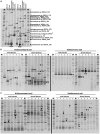Dynamics of seed-borne rice endophytes on early plant growth stages
- PMID: 22363438
- PMCID: PMC3281832
- DOI: 10.1371/journal.pone.0030438
Dynamics of seed-borne rice endophytes on early plant growth stages
Abstract
Bacterial endophytes are ubiquitous to virtually all terrestrial plants. With the increasing appreciation of studies that unravel the mutualistic interactions between plant and microbes, we increasingly value the beneficial functions of endophytes that improve plant growth and development. However, still little is known on the source of established endophytes as well as on how plants select specific microbial communities to establish associations. Here, we used cultivation-dependent and -independent approaches to assess the endophytic bacterrial community of surface-sterilized rice seeds, encompassing two consecutive rice generations. We isolated members of nine bacterial genera. In particular, organisms affiliated with Stenotrophomonas maltophilia and Ochrobactrum spp. were isolated from both seed generations. PCR-based denaturing gradient gel electrophoresis (PCR-DGGE) of seed-extracted DNA revealed that approximately 45% of the bacterial community from the first seed generation was found in the second generation as well. In addition, we set up a greenhouse experiment to investigate abiotic and biotic factors influencing the endophytic bacterial community structure. PCR-DGGE profiles performed with DNA extracted from different plant parts showed that soil type is a major effector of the bacterial endophytes. Rice plants cultivated in neutral-pH soil favoured the growth of seed-borne Pseudomonas oryzihabitans and Rhizobium radiobacter, whereas Enterobacter-like and Dyella ginsengisoli were dominant in plants cultivated in low-pH soil. The seed-borne Stenotrophomonas maltophilia was the only conspicuous bacterial endophyte found in plants cultivated in both soils. Several members of the endophytic community originating from seeds were observed in the rhizosphere and surrounding soils. Their impact on the soil community is further discussed.
Conflict of interest statement
Figures




Similar articles
-
Characterizing endophytic competence and plant growth promotion of bacterial endophytes inhabiting the seed endosphere of Rice.BMC Microbiol. 2017 Oct 26;17(1):209. doi: 10.1186/s12866-017-1117-0. BMC Microbiol. 2017. PMID: 29073903 Free PMC article.
-
Conservation and transmission of seed bacterial endophytes across generations following crossbreeding and repeated inbreeding of rice at different geographic locations.Microbiologyopen. 2019 Mar;8(3):e00662. doi: 10.1002/mbo3.662. Epub 2018 Jun 10. Microbiologyopen. 2019. PMID: 29888428 Free PMC article.
-
The influence of host genotype and salt stress on the seed endophytic community of salt-sensitive and salt-tolerant rice cultivars.BMC Plant Biol. 2018 Mar 27;18(1):51. doi: 10.1186/s12870-018-1261-1. BMC Plant Biol. 2018. PMID: 29587643 Free PMC article.
-
Insights into the early stages of plant-endophytic bacteria interaction.World J Microbiol Biotechnol. 2021 Jan 4;37(1):13. doi: 10.1007/s11274-020-02966-4. World J Microbiol Biotechnol. 2021. PMID: 33392741 Review.
-
Recent progress in the role of seed endophytic bacteria as plant growth-promoting microorganisms and biocontrol agents.World J Microbiol Biotechnol. 2024 May 29;40(7):218. doi: 10.1007/s11274-024-04031-w. World J Microbiol Biotechnol. 2024. PMID: 38806849 Review.
Cited by
-
Dynamics Relationship of Phyllosphere and Rhizosphere Bacterial Communities During the Development of Bothriochloa ischaemum in Copper Tailings.Front Microbiol. 2020 May 28;11:869. doi: 10.3389/fmicb.2020.00869. eCollection 2020. Front Microbiol. 2020. PMID: 32547500 Free PMC article.
-
Insights into the endophytic bacterial community comparison and their potential role in the dimorphic seeds of halophyte Suaeda glauca.BMC Microbiol. 2021 May 12;21(1):143. doi: 10.1186/s12866-021-02206-1. BMC Microbiol. 2021. PMID: 33980153 Free PMC article.
-
Wheat seed embryo excision enables the creation of axenic seedlings and Koch's postulates testing of putative bacterial endophytes.Sci Rep. 2016 May 6;6:25581. doi: 10.1038/srep25581. Sci Rep. 2016. PMID: 27151146 Free PMC article.
-
Dynamic Changes in the Microbiome of Rice During Shoot and Root Growth Derived From Seeds.Front Microbiol. 2020 Sep 8;11:559728. doi: 10.3389/fmicb.2020.559728. eCollection 2020. Front Microbiol. 2020. PMID: 33013792 Free PMC article.
-
Endophytic Bacteria Associated with Origanum heracleoticum L. (Lamiaceae) Seeds.Microorganisms. 2022 Oct 21;10(10):2086. doi: 10.3390/microorganisms10102086. Microorganisms. 2022. PMID: 36296360 Free PMC article.
References
-
- Dias ACF, Costa FEC, Andreote FD, Lacava PT, Teixeira MA, et al. Isolation of micropropagated strawberry endophytic bacteria and assessment of their potential for plant growth promotion. World J Microbiol Biotechnol. 2009;25:189–195.
-
- Lucero M, Barrow JR, Osuna P, Reyes I. A cryptic microbial community persists within micropropagated Bouteloua eriopoda (Torr.) Torr. cultures. Plant Sci. 2008;174:570–575.
-
- Baker KF, Smith SH. Dynamics of seed transmission of plant pathogens. Annu Rev Phytopathol. 1966;14:311–334.
-
- Mano H, Tanaka F, Watanabe A, Kaga H, Okunishi S, et al. Culturable surface and endophytic bacterial flora of the maturing seeds of rice plants (Oryza sativa) cultivated in a paddy field. Microbes Environ. 2006;21:86–100.
Publication types
MeSH terms
Associated data
- Actions
- Actions
- Actions
- Actions
- Actions
- Actions
- Actions
- Actions
- Actions
- Actions
- Actions
- Actions
- Actions
- Actions
- Actions
- Actions
- Actions
- Actions
- Actions
- Actions
- Actions
- Actions
- Actions
- Actions
- Actions
- Actions
- Actions
- Actions
- Actions
- Actions
- Actions
- Actions
- Actions
LinkOut - more resources
Full Text Sources
Other Literature Sources
Molecular Biology Databases
Miscellaneous

